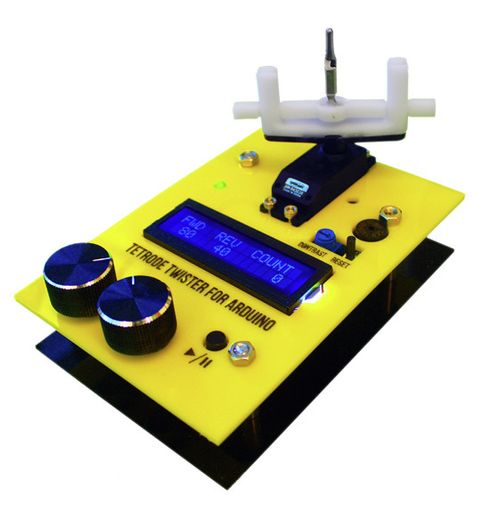Twister
The Twister is an open-source tetrode twister based on Arduino.
Assembled Twisters are available from LabMaker. If you want to build your own, either download or clone the repository on GitHub, then follow the instructions in the Twister assembly manual.
General Information
Building one or more Twisters is a great way to expand your lab's tetrode-making capabilities without breaking the bank. The Twister was designed to equal or surpass all commercially available products in terms of quality, while also being less expensive. Furthermore, all of the source files are freely available, allowing you to modify the design as you see fit. Assembling your own Twister is also a great way to learn the basics of electronics. The Twister contains a microcontroller, an LCD display, a servo motor, a voltage regulator, photocells, potentiometers, buttons, and more. If you know how all of the pieces work together, you'll have a solid foundation in electronic circuits, which you can use to start building your own devices. Knowing your way around a circuit board is incredibly empowering, especially for those of us working in electrophysiology. This document contains a complete parts list, assembly instructions, and troubleshooting hints for constructing your own Twister. Once you've collected all the supplies, it should take about 2 hours to put together. After that, you'll be able to twist tetrodes to your heart's content.
Although the following instructions list all of the information and tools necessary for building the Twister itself, you'll need some more supplies to actually start twisting tetrodes. These include a pair of sharp scissors (BRI model 25-1000 are expensive, but work amazingly well), forceps for handling tetrodes (Fine Science Tools's ceramic-tip model is extremely reliable), and a tetrode stand (McMaster-Carr item #1958A31 is recommended). You may want to tape a small metal cannula to the stand (17 gauge is about right) to support the tetrode itself. And, of course, you'll also need tetrode wire, which can be purchased on Amazon (Sandvik Kanthal HP Reid Precision Fine Tetrode Wire, Nickel-Chrome 0.012 mm diameter, various lengths). If you need more background information on the tetrode-making process, check out the following article in the Journal of Visualized Experiments: www.jove.com/details.php?id=1098
If you've never done any soldering before, and don't have anyone who can teach you the basics, check out the online tutorial at SparkFun (www.sparkfun.com/tutorials/106) . It's really easy once you get the hang of it. This site has a lot of other useful electronics tutorials that offer a great starting point for someone new to electronics.
